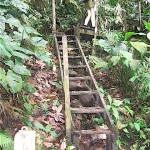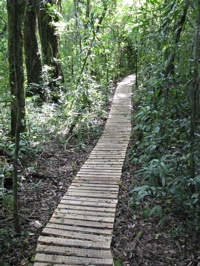The other day I was scanning articles about Costa Rica in the archives of Outside Magazine, and I came upon one in which a traveller asks for gear advice for an upcoming trip to Costa Rica. The question was about rain gear and footwear for hiking in a rainy climate. Now, I have a lifetime of almost everyday hiking and 15 years of year-round hiking and guiding in Costa Rica, but I am definitely not a gear head or equipment junkie, so I can’t comment on whether the Outside advisor’s recommendations were good, or not. What struck me was how differently I would try to answer that question.
El otro día estaba revisando artículos sobre Costa Rica en los archivos de Outside Magazine, cuando me topé con uno en el cual un viajero preguntaba sobre equipo de lluvia y zapatos para hiking en clima lluvioso. Si bien, tengo toda una vida de caminar casi a diario y 15 años de caminatas y guiar todo el año en Costa Rica, no estoy obsesionado con ningún “equipo”, así que no puedo hacer comentarios en cuanto a si las recomendaciones de la revista eran buenas, o malas. Lo que sí me impactó fue cuán diferente habría sido mi respuesta a la pregunta del viajero.
My answer would be based not so much upon the performance of the gear as to the health and safety of the hiker. To me, this means that rain gear must protect you from getting hypothermic while on the trail in rainy conditions, and footwear should keep you from falling (as best can be expected) in a country known for steep and slippery trails.
Mi respuesta se habría basado no tanto en la actuación del equipo, sino en la salud y seguridad del caminante. Para mí, esto significa que el equipo impermeable deberá protegerte para que no te dé hipotermia en un sendero con condiciones lluviosas, y tus zapatos deberán prevenir que te caigas (dentro de lo posible) en un país famoso por sus senderos empinados y resbalosos.
"Sombrilla de pobre" - This plant is called, "Poor Man's Umbrella"
RAIN GEAR: Costa Rica is one of the wettest countries on the planet. Naturally, it depends on where you are hiking on what day. The elevation goes from 0 to 3800 meters (12000 feet) in a very short distance from both oceans. People are often shocked at how cool it can be when they are expecting “tropical.”
EQUIPO DE LLUVIA: Costa Rica es uno de los países más mojados del planeta. Naturalmente, todo depende de dónde estés caminando en algún día determinado. La elevación va desde 0 a los 3800 metros (12000 pies) en poca distancia de ambos océanos. La gente a menudo se sorprende de cuán fresco puede ser, cuando estaban esperando clima “tropical”.
When it rains, the temperature can drop quickly. Even at sea level you can get chilled if your body temperature is not high and you are wet. At mid to higher elevations you can definitely get hypothermia. There is no one answer for all situations, which unfortunately, the traveller who wants to pack light, wants to hear. Will a breathable fabric work in 100% humidity, two inch per hour downpour, while you’re sweating profusely? Will vents help? I can’t say, because I haven’t tested rain gear, but my basic science classes from way back taught me that if you’ve got 100% moisture inside and out, then you’re wet. Period.
Cuando llueve, la temperatura puede bajar rápidamente. Incluso a nivel del mar puedes enfriarte si tu temperatura no es alta y estás mojado(a). A temperaturas media y alta, definitivamente te puede dar hipotermia. No hay una sola respuesta para toda situación, aunque el viajero que empaca liviano, desafortunadamente, quisiera saberla. Una tela que respire, ¿servirá en 100% humedad, aguacero de 5cm por hora, mientras sudas profusamente? ¿Servirá tener respiraderos? No puedo responder, porque no he probado ese equipo de lluvia, pero mis clases básicas de ciencias hace años me enseñaron que si tienes 100% humedad adentro y afuera, ¡te mojaste! Punto.

Tirimbina wet stairs - peldaños mojados en Tirimbina
These stairs are a perfect example of trail conditions we don’t think about—we just climb or descend! Obstacles and difficulties are part of hiking.
Estos peldaños son el ejemplo perfecto de condiciones en el sendero, las cuales no pensamos encontrar y, sin embargo, subimos o bajamos sin darle importancia. Obstáculos y dificultades son parte del hiking.
What’s important is that you stay warm. At low to mid elevations any reasonably good raincoat will do the trick. At higher elevations you’d better have something to put on under the raincoat—like a pile sweater—and get it on early when you are still warm. If you are backpacking, remember to protect your dry change of clothing with garbage bags or a backpack cover, and change into dry stuff immediately when you arrive. Don’t wait for your body temperature to drop. If you are day hiking, have a change of clothing ready in the car or room.
Lo importante es mantenerte tibio. A elevaciones entre bajas y medianas, cualquier buen impermeable te ayuda. A elevaciones más altas, deberás ponerte algo debajo del impermeable —como un suéter— y ponértelo antes de que te enfríes. Si estás mochilando, acuérdate de proteger tu muda seca dentro de bolsas de basura, y cámbiate de ropa apenas llegues. No esperes a que baje la temperatura de tu cuerpo. Si caminas por un día, mantén una muda lista en el auto o habitación.
Depending on the temperature and season at lower elevations, you may choose to just get wet. If the hike is not too long or the weather has been really hot, that may work. Many people travel with quick drying clothing. Pack a big zip-lock bag to protect your camera, passport, and wallet. Umbrellas work great with two exceptions: Too much wind turns them into a sail, and narrow brushy trails with low branches will catch and tear the umbrella.
Dependiendo de la temperatura y estación a elevaciones bajas, podrías optar por mojarte. Si la caminata no es muy larga y el clima ha estado bien caliente, tal vez eso sirva. Mucha gente viaja con ropa que seca rápido. Empaca una bolsa zip-lock para proteger la cámara, el pasaporte y la billetera. Los paraguas funcionan, con dos excepciones: Demasiado viento los convierte en vela, y en senderos con ramas bajas se te pega el paraguas y se te rompe.
FOOTWEAR: This is a subject we could probably write a book about, and I have seen it all over the years. Porters in Nepal or Peru may be comfy in flip flops, but you may be taking a big risk. Likewise with high heels or barefoot (there are burs, thorns and biting critters). Campasinos are born and raised in cheap rubber knee boots and almost never fall on slippery trails, but this may lack support and traction if you’re not used to it. To me, the most important thing is to protect your feet and avoid falling. Wet shoes, hot feet, performance, weight, drying time are all good but secondary issues. I’d rather hike all day in wet shoes than risk a cut or broken toe on a difficult river crossing. It’s better to pack the extra weight of a hiking boot you trust for tread and support, than to fall on a muddy trail due to worn out sneakers.
CALZADO: Este es tema para escribir un libro, lo cual he visto a través de los años. Los porteros en Nepal o Perú andan felices en sandalias, pero en sandalias tú corres un gran riesgo. Igual en tacones altos, o andando descalzos (hay mozotes, espinas y criaturas que muerden). Los campesinos crecen usando botas de hule baratas y casi nunca se caen en senderos resbalosos, pero tal vez les falte soporte y tracción si no estamos acostumbrados a usarlas. Para mí, lo más importante es protegerme los pies y no caerme. Zapatos mojados, pies calientes, actuaciones, peso y tiempo de secado son asuntos secundarios. Prefiero caminar todo el día con zapatos mojados, que arriesgarme a una cortada, o quebrarme un dedo en una cruzada de río. Es mejor empacar el peso extra de una bota de hiking que te guste por su rodadura y soporte, que caerse en el barro por andar en tennis viejas.
Costa Rican trails often do not have bridges, and rarely have switch backs. If you are going to more adventurous trails, you can expect steep and slippery, even in dry season. Even in more moderate “civilized” parks, trails can be slime covered but not very visible, walkways, roots, and rocks. The combination of a sticky rubber, good tread pattern, and for some of us, ankle support, works best. It’s the downhill that’s dangerous and that’s what you have to prepare for.
Los senderos costarricenses a menudo no tienen puentes y casi nunca tienen cambioatrás. Si vas a senderos más difíciles puedes esperar que sean empinados y resbalosos, incluso en la estación seca. Incluso en los parques más “civilizados”, los senderos pueden estar cubiertos de lodo sin ser visible, o tener pasadizos, raíces salidas, y rocas. La combinación del agarre del hule, buen patrón de rodadura y, para algunos como yo, buen soporte de tobillo, es lo mejor. Es la cuesta abajo la que es peligrosa y para eso es que debemos prepararnos.
On the trail there is no substitute for caution. Wood that you step on may be slippery or rotten, whether it’s natural roots, a fallen log, or a constructed walkway. Earth trails may be slick clay or loose mud. Rocks should be tested before putting too much trust in them. Some folks like walking sticks and they can be a great help. I have seen people put too much weight on them and they too can slide out. On some hikes it’s worth the extra weight to pack a pair of water shoes or sandals for river crossings. If packing light for your trip is not an issue, and you have a car or home base to hike from, you can bring down a variety of footwear so you can test what works. Let me know if you find the perfect footwear.
Al caminar hay que tener cuidado. La madera en que te paras puede estar resbalosa o podrida, ya sean raíces, un tronco caído, o un pasaje construido. Senderos de tierra pueden ser de arcilla resbalosa, o lodo flojo. Hay que probar cuándo puedes pararte en las rocas. Hay gente que usa bastones, los cuales ayudan y, sin embargo, he visto gente que pone demasiado peso en ellos y se les tuercen. En algunas caminatas vale la pena tener zapatos de agua, o sandalias, para curzar ríos. Si no necesitas empacar liviano y tienes una casa o base desde dónde empezar, puedes traer variedad de calzado para probar qué te sirve. Cuéntame si encuentras el calzado perfecto.

trail near Steinvorth's property